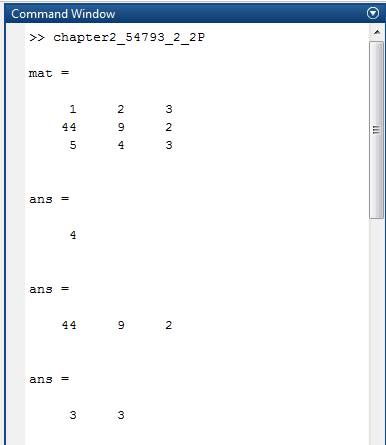
Concept explainers
To find:
The output of the following sequence of statements and expressions, and verify them.
mat = [1:3; 44 9 2; 5:-1:3]
mat(3, 2)
mat(2,:)
size(mat)
mat(:, 4) = [8;11;33]
numel(mat)
v = mat(3,:)
v(v(2))
v(1) = []
reshape(mat, 2, 6)
Answer to Problem 2.2P
Solution:
The output of the following sequence of statements and expressions:
“mat = [1:3; 44 9 2; 5:-1:3]”, “mat(3, 2)” “mat(2,:)”, “size(mat)”, “mat(:, 4) = [8;11;33]”, “numel(mat)”, “v = mat(3,:)”, “v(v(2))”, “v(1) = []”, and “reshape(mat, 2, 6)” are “
Explanation of Solution
Consider the following statement,
mat = [1:3; 44 9 2; 5:-1:3]
The statement will generates the matrix with the elements of the row with 1, 2, 3; second row 44, 9, 2; and the third row with 5, 4, 3.
So, the output is “
Consider the following statement,
mat(3, 2)
This command generates the value that is placed at third row and second column of the matrix “mat”.
So, the output is “ans = 4”.
Consider the following statement,
mat(2,:)
This command generates the second row elements of the matrix “mat”.
So, the output is “ans = 44 9 2”.
Consider the following statement,
size(mat)
This command generates the order of matrix.
So, the output is “ans = 3 3”.
Consider the following statement,
mat(:, 4) = [8;11;33]
This command includes the fourth column to the matrix “mat”.
So, the output is “
Consider the following statement,
numel(mat)
This command generates the number of elements present in the matrix “mat”.
So, the output is “ans = 12”.
Consider the following statement,
v = mat(3,:)
This command generates the third row elements from the matrix “mat”.
So, the output is “5 4 3 33”.
Consider the following statement,
v(v(2))
Since,
So, the output is “ans = 33”.
Consider the following statement,
v(1) = []
This command generates the elements of “v” eliminating the first elements.
So, the output is “v = 4 3 33”.
And consider the following statement,
reshape(mat, 2, 6)
This command changes the order of the matrix from
So, the output is “
MATLAB Code:
clc
clear all
close all
mat = [1:3; 44 9 2; 5:-1:3]
% Define the instruction in which the statement will generates the matrix with the elements of the row with 1, 2, 3; second row 44, 9, 2; and the third row with 5, 4, 3.
mat(3, 2)
% Define the instruction in which the command generates the value that is placed at third row and second column of the matrix “mat”.
mat(2,:)
% Define the instruction in which the command generates the second row elements of the matrix “mat”.
size(mat)
% Define the instruction in which the command generates the order of matrix.
mat(:, 4) = [8;11;33]
% Define the instruction in which the command includes the fourth column to the matrix “mat”.
numel(mat)
% Define the instruction in which the command generates the number of elements present in the matrix “mat”.
v = mat(3,:)
% Define the instruction in which the command generates the third row elements from the matrix “mat”.
v(v(2))
% Define the instruction in which the command generates the value of the v(v(2)).
v(1) = []
% Define the instruction in which the command generates the elements of “v” eliminating the first elements.
reshape(mat, 2, 6)
% Define the instruction in which the command changes the order of the matrix from 3 into 3 to 2 into 6.
Save the MATLAB script with name, chapter2_54793_2_2P.m in the current folder. Execute the script by typing the script name at the command window to find the answer of the given following sequence of statements and expressions.
Result:



Therefore, the output of the following sequence of statements and expressions:
“mat = [1:3; 44 9 2; 5:-1:3]”, “mat(3, 2)” “mat(2,:)”, “size(mat)”, “mat(:, 4) = [8;11;33]”, “numel(mat)”, “v = mat(3,:)”, “v(v(2))”, “v(1) = []”, and “reshape(mat, 2, 6)” are “
Want to see more full solutions like this?
Chapter 2 Solutions
Matlab Fourth Edition: A Practical Introduction to Programming and Problem Solving
- Algebra & Trigonometry with Analytic GeometryAlgebraISBN:9781133382119Author:SwokowskiPublisher:Cengage
